
Features
Crop Culture
Inputs
Growing in the Green: A better brachyscome crop
March 1, 2011 By Melhem Sawaya
This is the first in a series of vegetative crop production features Brachyscome is a very floriferous plant.
This is the first in a series of vegetative crop production features Brachyscome is a very floriferous plant. It has lacy green foliage topped with masses of blue, daisy-like flowers. It is a very compact plant, requiring extra attention to establish a large plant before flowering. Brachyscome could be used in 10” and 6” hanging baskets.
A well-grown 4” plant will be an excellent addition to New Guinea impatiens and geraniums, or any other 4” flowering plant. This is due to its different flower shape and popular colour. The 4” pots could be planted in gardens or mixed in window and patio planters.
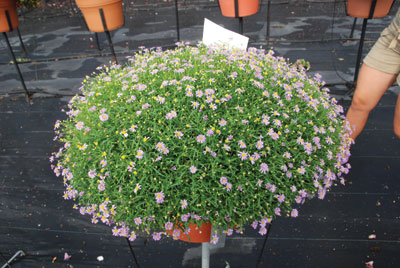 |
|
| Brachyscome Outback Daisy Mauve Delight. Advertisement
|
|
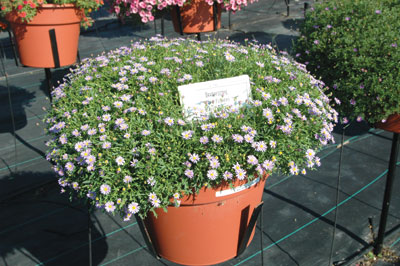 |
|
| Brachyscome mauve delight.
|
Brachyscome is a day neutral plant. The key to producing a high-quality, large hanging basket is to regulate the ratio of flowers to vegetative growth. It will flower faster under high light levels especially if accompanied with fairly high temperatures of 21–25ºC.
Brachyscome loves very high light levels of 3,000-5,000 foot-candles, which will enhance flowering greatly. Growing the plants under lower light levels of about 2,000 foot-candles at the start of the crop could encourage vegetative growth.
Brachyscome can survive temperatures ranging from 0ºC to 35ºC. The optimum temperature would be 23ºC (days) and 16ºC (nights). Like most other plants, at low light levels it grows sturdier at the lower temperature levels. If brachyscome is started in the fall, when low light levels prevail, it should be grown 13ºC to 16ºC to build a compact, bushy plant.
A CONSTANT LOW-FERTILIZER PROGRAM IS A MUST
A constant low-fertilizer program is a must for brachyscome. This would be a balanced formulation ratio of nitrogen (4), phosphorus (1), potassium (3), calcium (2) and magnesium (1). These ratios will assist in establishing the plant size before bud set. Checking salt or EC levels is more important in brachyscome than in most other plants. A high salt level will hinder plant growth and the plant size to flower will diminish drastically. The soil EC level target should be 0.8-0.9 mmhos continuously 2:1 ratio water to soil. If you don’t have an EC meter by now, or are not using it regularly with all your crops, you are potentially setting yourself up for longer crop time, crop losses, or a definite disaster.
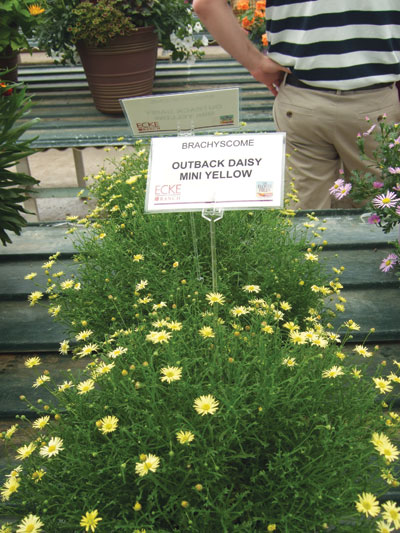 |
|
| Outback daisy mini yellow. |
Brachyscome has small leaves, which means overwatering is detrimental because the plant cannot perspire the high volume of water. This happens especially if the plant is small and the light levels are low, which are the exact conditions in the fall. If you are one of those growers who gives plants a good watering on Friday so you don’t have to water on Sunday, with brachyscome you might not need to ever water them again… because they’ll be dead.
Since brachyscome is sensitive to overwatering, a well-drained soil mix is a must. A mix of 65 per cent peat moss, 15 per cent vermiculite and 20 per cent perlite with a pH adjusted to 5.6 is best.
DO YOU NEED TO APPLY A FUNGICIDE?
Check liners before planting, and apply the appropriate fungicide, especially if there are signs of Botrytis. This will minimize disease spreading, and it is more economical. Plant liners into moistened soil, shower very lightly and remember the water needs to go the depth of the liner roots only. This means the water volume increases with root growth but not before.

|
The previous chart is a guide for the number of liners required per pot size and the approximate crop time from liner to finish.
The crop time can vary depending on the size of the finished crop your market demands.
Brachyscome does not require any pinching, since it is self-branching.
Brachyscome can be grown pot to pot for a long time. It is only at the last 30 per cent of its growing time that it needs spacing.
Suggested spacing could be:
 |
Keep brachyscome hanging baskets on benches as long as possible since evaluating moisture saturation on a bench is easier.
Brachyscome will be stronger and bushier if only 500 ppm B-nine is applied every 10 days for the purpose of delaying flowers and increasing strong vegetative growth.
Again, the best growth regulators are water frequency, fertilizer type and concentration, light levels, temperature level and deliverance, or the combination of all of the above to model your plant.
EASILY SUSCEPTIBLE TO DISEASE IF STRESSED
Brachyscome is easily susceptible to diseases if it is stressed. Overwatering, excessive dryness and high salt levels are the main causes of this stress. At the same time, there are no diseases specifically associated with brachyscome.
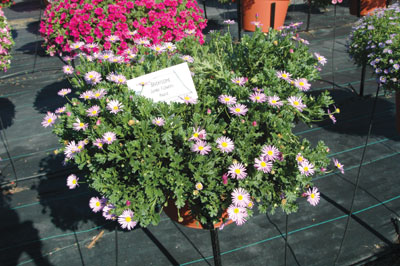
|
|
| Brachyscome Jumbo Mauve.
|
|
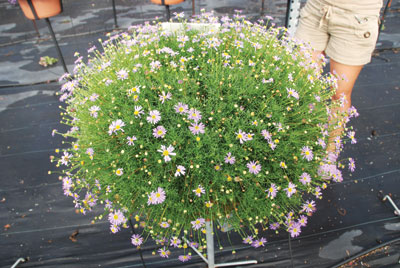 |
|
| Toucan Tango.
|
|
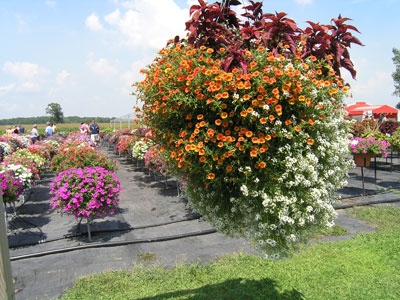 |
|
| The annual hanging baskets competition at the Sawaya Garden Trials is a crowd favourite. PHOTOS COURTESY MELHEM SAWAYA
|
Check the plant and don’t go to any extremes, and brachyscome will not have any problems.
If it does not show any flowers after a long period of growing, most probably they are hosting a thrips party. A preventive thrips spray and biological program is a must. This is because you cannot stop a party in midstream. As well, spider mites could cause severe damage if they are not treated. All spray/biological treatments should be done at an early stage to avoid flower spray damage or finding the problem at shipping time.
Brachyscome have small leaves, and overwatering during low-light periods will definitely cause yellowing and stunted growth. Moderate fertilization, moist but not wet media, and optimum temperatures at the right growth stage will help prevent this problem. Yellowing of brachyscome is the direct result of not applying the culture we talked about.
As we said before, the right schedule is yours to find, but by following the guidelines discussed earlier, you should be happy with the results. By keeping the following records, you will be able to adjust, improve, or repeat producing the crop you had this year.
- Planting date.
- Size of liners/container.
- Number of liners/containers.
- Temperature.
- Light conditions (in general), or how many layers of baskets were grown above the crop, if any.
- Fertilization type and concentration.
- Any specific problems or setbacks.
- Shippable stage, not shipping date.
- Be objective and listen to suggestions from your employees. What was the response by customers to your product?
- Write next year’s program and changes by the end of this year, since memory can and will fail.
Keep this in mind: if you keep doing what you have been doing, you are going to be getting what you have been getting.
FIRST IN A SERIES ON VEGETATIVE CROPS
I will be writing a vegetative crops production series over the next few issues, interrupted only by the months we feature the California showcase and the Sawaya garden trials. I will be concentrating on crops that have excellent garden performance and that are drastically underutilized. If you have a crop in mind that you strongly believe needs to be covered don’t hesitate to send me an e-mail to outline why it needs to be featured.
Please note: This summer’s Sawaya Garden Trials open house has been moved to July 20th.
Melhem Sawaya of Focus Greenhouse Management is a consultant and
research coordinator to the horticultural industry. Comments on this or
any other article are always welcome at
mel@focusgreenhousemanagement.com, or by visiting www.focusgreenhousemanagement.com or www.sawayagardentrials.ca .
Print this page